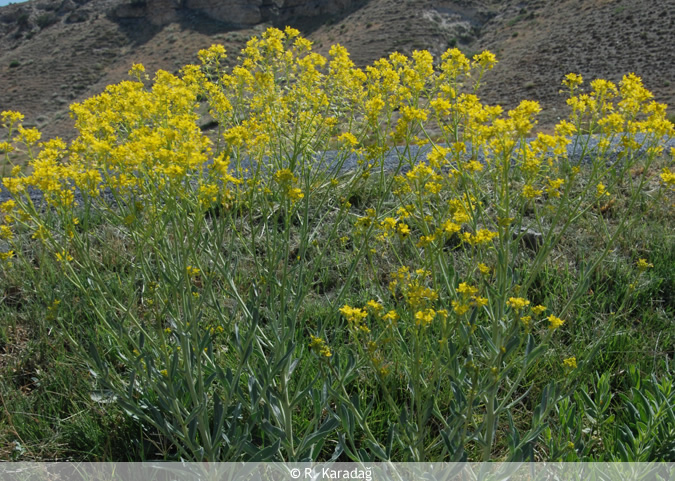Dyer's woad, or simply woad, is a biannual plant. In the first year, it only develops a rosette of leaves close to the ground. In the second year, it grows a stem of about three feet with lots of small, dark yellow flowers in clusters. The arrow-shaped leaves that surround the stem are bluish-green and contain the indigo precursor substances isatan A and B, indoxyl-derivatives. Isatans differ from the indican in Indigofera tinctoria and other indigo plants only in that instead of glucose being bound to the indoxyl,they are bound to D-ribohexo-3-ulopyranosides. When this is split from the isatans, however, the yellow indoxyl and sugars result, just as with the splitting of indican.It is thought that woad, Isatis tinctoria, was originally native to the Caucasian steppes and farther east to the Himalayas . Now, through cultivation, it grows in Europe and even in North Africa . The Isatis genus has many subspecies, 30 alone in Turkey . It is unknown whether Isatis tinctoria itself grows in Turkey . Isatis indigotica grows throughout northern China and is used for blue-dyeing.Historical Data
Woad was the source for indigo in Greece , in the Roman Empire, and, from the Middle Ages, throughout Europe . Woad flourished in areas such as Thuringen in Germany and around Toulouse in France , and they thrived from woad, and became rich from it - at least the woad dealers did. But in competition with the almost pure indigo from India, woadballs with their low content of indigo were at a disadvantage as soon as trade on the sea route to India increased, bringing Indian indigo to the European market. Import restrictions had little effect. When India finally became a British colony and the English established immense works for the production of indigo, as did the Dutch in Indonesia , all the protection barriers around Europe collapsed.
Napoleon's was the last. The woad regions became impoverished. Only a few woad-farmers and woad dyeworks survived into the 20th century. Since about 1990, there have been efforts to revitalize woad-dyeing in Europe , mainly as hobby projects by enthusiasts. One of these, however, that of Denise and Henri Lambert in Lectoure is now producing woad-indigo in agro-industrial volumes. Historically, indigo has been obtained from the leaves of Isatis tinctoria by a complex process that involved fermentation. The dye is rarely used nowadays, having been replaced at first by pigment from the tropical plant Indigofera tinctoria and more recently by synthetic dyes, which have reduced the use of both of these plants.

